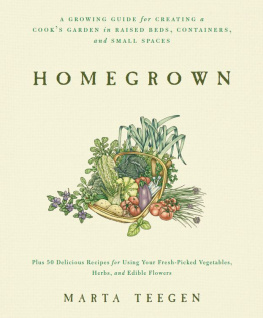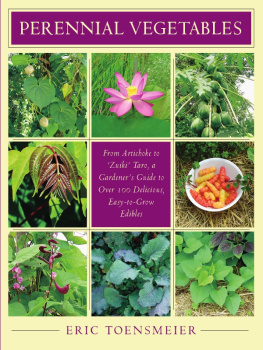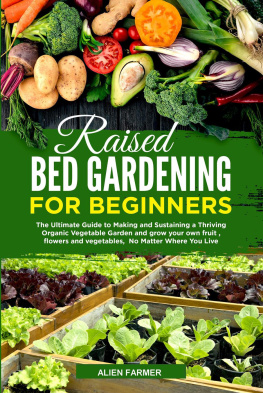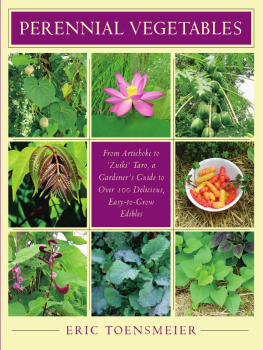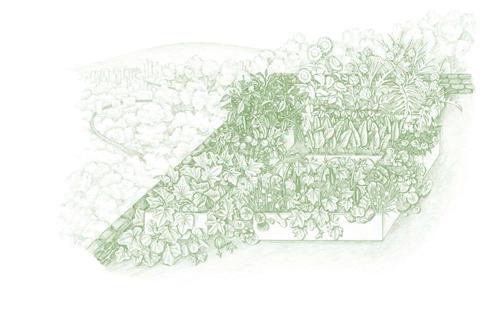The year before I started my kitchen garden design business, Homegrown LA, I was living on a hilltop in the Mt. Washington neighborhood of Los Angeles, between downtown and Pasadena. I had recently returned from 6 months of study with home cooks in India and was eager to continue to work with food, but I knew that the long hours and low pay of restaurant work and catering or being a freelance home chef was not for mebecause Id already done all of those things.
In thinking about my future, I decided to convert my front yard into a vegetable garden. Although I had spent time on my familys farms as a child, I didnt consider myself a gardener. Im a cook first, and I know the pleasures of fresh produce. But I knew that I was interested in growing many of the vegetables I had learned to cook with and had seen at the farmers markets in Los Angeles.
My first kitchen garden in LA was a little over 200 square feet in size and included heirloom varieties from A to Z (well, to W, to be truthful). It was an ambitious project, and it taught me many things about planting, spacing, harvesting, and, most of all, appreciating the flavors and textures of just-picked vegetables and herbs.
WHAT I GREW IN MY FIRST KITCHEN GARDEN
My first garden included these vegetables: artichokes, arugula, beets, bell peppers, broccoli, cabbage, cantaloupe, carrots, cauliflower, celery, chile peppers, cucumbers, eggplants, endive, Florence fennel, garlic, green beans, leeks, lettuce, onions, peas, potatoes, pumpkins, radicchio, radishes, shallots, sorrel, soybeans, spinach, strawberries, sweet corn, Swiss chard, tomatoes, upland cress, and watermelon.
And these herbs: basil, chives, cilantro, dill, marjoram, mint, oregano, parsley, rosemary, sage, tarragon, and thyme.
And these edible flowers: borage, calendula, nasturtiums, sunflowers, and violets.
I quickly realized that I liked having daily access to fresh greens and herbs, both for salads and for cooking. Tomatoes and melons were also a definite treat. Consequently, my garden was transformed into a salad garden after that first year, with a melon patch alongside.
In my eyes, the plants in my garden produce ingredients for meals, and I spend much more time choosing what to harvest on a given day than I spend actually cooking. By being in the garden for a few minutes every day, I can easily see when its time to gather my homegrown bounty at its peak of freshness.
Soon after my garden was planted, I began throwing regular dinners for friends, building menus that featured the produce from my impressively reliable front-yard farm. It was surprisingly simple and, as a cook, an ongoing source of inspiration and play. I was no longer teasing out an elusive nuance of flavor from a vegetable that had been picked too early; I was now working in a palate of bold tastes and textures, colors, and shapes with produce picked at its peak and potential.
Then I began to get requests to design similar kitchen gardens for families and friends throughout the cityso Homegrown LA was born.
The vegetable gardens I design come in a variety of shapes, sizes, and colors, but they all share distinctive qualities. They are consistently and predictably productive while also visually entrancing, exuding a dreamy exuberance that suggests the romantically unkempt gardens of rural French villages.
My intensively planted gardens are designed to take root in spaces usually off-limits to vegetables, such as weedy nooks, tangled corners, and front yards. There are only two basic requirementsadequate sun and nutrient-rich soil. The results are impressive and well within your reach. With Homegrown as your guide, you simply choose the vegetables (and herbs and edible flowers!) you like to eat, create easy-care garden beds and containers, tend to your plants as they grow, and harvest your bounty for delicious meals every day. Youll discover that kitchen gardening is rewarding beyond measure, both for you as a gardener and for you as a lover of organic, fresh, and flavor-filled dishes.
Marta Teegen
What looks good today?
Its a simple enough question when youre at the market, running your fingers over a tomato, subtly squeezing it, and wondering if that waxy sheen is natural or not. Its markedly more complicated when youre shopping for food to serve at an organic restaurant.
One of my restaurant jobs took me to the aisles of the Santa Monica farmers market, looking for both the staples and the exotic items, mentally keeping track of the changes we would need to make to the menu based on what was perfectly ripe that day.
In my world, my garden, and my kitchen, something is either ready to eat, at the peak of its freshness, or its not.
Its that simple.
Unfortunately, this is not the case in the produce sections of most supermarkets. There, ripeness is a subjective term, and any appearance of ripeness may be a mere gilding of the lily, as maturity is not actually achieved but rather is applied through the processes of industrial food production. Veggies are taken from the field still green and are then sprayed with chemical showers to protect their skin, speed up coloration, and delay spoilage.
From the cooks point of view, there is no comparison between fresh from the garden and fresh from the grocery store bag. If you dont have the best-quality ingredients to work with, it doesnt matter what youre doing with them: The results will always be average. Once you are able to eat food at peak ripeness after growing it perfectly yourself, youll never go back to the grocery store.
As a kitchen garden designer, I have developed a few guiding principles: Prepare your garden based on what you eat, have good materials at the start, look to nature as your guide for both diversity and design, andlike naturebe patient as well as ruthless.
PLANT WHAT YOU EAT
It is essential to remember that the goal is to plant your garden based on your eating habits and then to plan meals based on what is harvestable at any given time. While you may have to wait through a long summer to harvest the first Charentais melon, the sweetness of its flesh, still warm from the sun, is incomparable. As I patiently wait for my tomatoes to mature, I enjoy a salad of mixed lettuces, arugula, chives, dill, marjoram, parsley, sorrel, and upland cress. And when my tomatoes do come in, my basil will be at least 2 feet tall, which means I can finally make pasta with fresh tomato sauce thats seasoned with fresh basil Ive picked myself.
Ask yourself: What do you like to eat fresh? What do you eat again and again? What grows easily in your backyard microclimate? For me, it is very special to have daily access to fresh greens. This is my personal preference, and its the reason I can always build a meal around whats in my garden, 50 feet from my kitchen. My first year, I planted a very wide variety of vegetables just to see what would work and what I wanted. I slowly pared that back to mostly cooking greens, salad greens, melons, and tomatoes.
DEFINITIONS
Intensive planting, interplanting, companion planting. These three terms describe three techniques for planting within the microclimate of your garden. Intensiveplanting means spacing plants close together and allowing them to overlap, sometimes even crowding each other significantly.

